

Erismena is an opera in a prologue and three acts by Francesco Cavalli. First performed in Venice in 1655, it was designated as a dramma per musica .


Erismena is an opera in a prologue and three acts by Francesco Cavalli. First performed in Venice in 1655, it was designated as a dramma per musica .
The Italian libretto was by Aurelio Aureli, the only work by this writer for Cavalli. It was dedicated to Giacomo Cavalli (1617-1674), one of the sons of Federico Cavalli (1567-1618), benefactor of the composer. [1] The work is also unusual for having been translated into English in the 17th century. Erismena is the first full-length opera known to have been translated into English and may have been first performed in England in 1674.
The performance history indicates that the opera was well received. [2] It was first performed in Venice at the Teatro Sant'Apollinare on 30 December 1655 [3] with further performances between that date and 28 February 1656. Cavalli revised the work in 1670. Both versions have survived as well as one with an English translation, also dated to the 17th century.
The opera was revived in the 20th century, and was performed in California. In the 21st century the opera has been performed by English Touring Opera, [4] and by Leonardo García Alarcón and the Cappella Mediterranea for the Festival d'Aix-en-Provence.
| Role | Voice type | Premiere Cast, 30 December 1655 (Conductor: - ) |
|---|---|---|
| Erimante, King of Media | bass | |
| Erismena, daughter of Erimante | soprano | |
| Aldimira, favourite of Erimante | soprano | |
| Alcesta, Aldimira's former nurse | contralto | |
| Idraspe (Erineo), Prince of Iberia | contralto | |
| Orimeno, Prince of Colchus | soprano | |
| Agrippo, servant of Orimeno | bass | |
| Diarte, a prison guard | bass | |
| Clerio | soprano | |
| Flerida | soprano | |
| Oriste | bass | |
Many opera scores by Cavalli have survived among the manuscripts of Venice's Biblioteca Marciana. According to Grove, there are two versions of Erismena in the Marciana, the later one being an adaptation for a 1670 revival. [5] There is another score in the Bodleian Library, Oxford.
While the libretto was published in 1655, the score was not published until 2018 when Bärenreiter edition appeared, based on one of the Marciana scores and the Bodleian score. [2]
A manuscript score of Erismena, with English libretto, is the oldest surviving opera score in England, [2] dating from the 1670s. The score was in a private library until 2008. A public subscription raised £85,000 to donate the score to the Bodleian Library, Oxford, after export of the score had been blocked by the British Reviewing Committee on the Export of Works of Art. The manuscript has a unique allegorical prologue, with characters who do not feature in the opera; this is believed to indicate that the version was performed, or intended to be performed, for a Royal audience. [6]
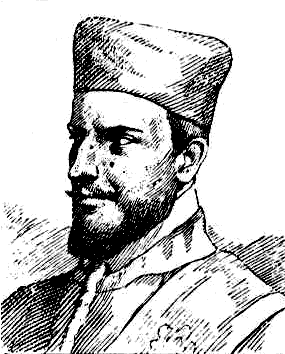
Francesco Cavalli was a Venetian composer, organist and singer of the early Baroque period. He succeeded his teacher Claudio Monteverdi as the dominant and leading opera composer of the mid 17th-century. A central figure of Venetian musical life, Cavalli wrote more than thirty operas, almost all of which premiered in the city's theaters. His best known works include Ormindo (1644), Giasone (1649) and La Calisto (1651).
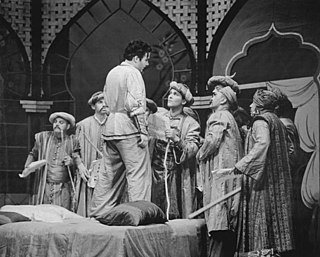
Abu Hassan is a comic opera in one act by Carl Maria von Weber to a German libretto by Franz Carl Hiemer, based on a story in One Thousand and One Nights. It was composed between 11 August 1810 and 12 January 1811 and has set numbers with recitative and spoken dialogue. The work is a Singspiel in the then popular Turkish style.
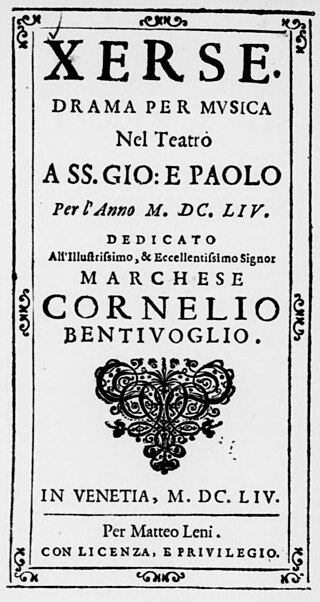
Il Xerse, usually written Xerse, is an Italian opera by Francesco Cavalli about Xerxes I. The libretto was written by Nicolò Minato and was later set by both Giovanni Bononcini and George Frideric Handel. Minato's plot outline is loosely based on Book 7 of Herodotus's Histories. The opera, consisting of a prologue and three acts, was composed in 1654 and first performed on 12 January 1655 at the Teatro SS. Giovanni e Paolo in Venice. It was dedicated to the Ferrarese nobleman Marchese Cornelio Bentivoglio.

Scipione affricano is an opera in a prologue and three acts by Francesco Cavalli. It was designated as a dramma per musica. The Italian libretto was by Nicolò Minato, based on Livy's "The Continence of Scipio".

Pompeo Magno is an opera in three acts by Francesco Cavalli. It was designated as a dramma per musica. The Italian libretto was by Nicolò Minato.

Oristeo is an opera in a prologue and three acts by Francesco Cavalli. It was designated as a dramma per musica. The Italian libretto was by Giovanni Faustini.

Ercole amante is an opera in a prologue and five acts by Francesco Cavalli. Its Italian libretto is by Francesco Buti, based on Sophocles' The Trachiniae and on the ninth book of Ovid's Metamorphoses. The first performance took place on 7 February 1662 in the Salle des Machines of the Tuileries in Paris.

Xerse (Xerxes) is an opera in three acts by Giovanni Bononcini. It was designated as a dramma per musica. The libretto was written by Silvio Stampiglia after that by Nicolò Minato which had been used for the 1654 opera of the same name by Francesco Cavalli. Stampiglia's version was in turn used as the basis for Handel's Serse.

Eritrea is an opera in three acts by the Italian composer Francesco Cavalli. The libretto is by Giovanni Faustini. It was premiered at the Teatro Sant'Apollinare in Venice on 17 January 1652, and revived in modern times at the Wexford Festival in 1975 under the conductor Jane Glover.

Ciro (Cyrus), also written Il Ciro, is a 1653 Italian drama per musica (opera) in a prologue and three acts with music by Francesco Provenzale and a libretto by Giulio Cesare Sorrentino. The story concerns the Persian king Cyrus the Great. The opera was probably first performed during Carnival of that year at the Teatro San Bartolomeo in Naples, in a production by Giovan Battista Balbi.

Veremonda, l'amazzone di Aragona is an opera in three acts and a prologue by the Italian composer Francesco Cavalli. The libretto is by Giulio Cicognini with revisions by Giulio Strozzi. The date of the Venetian performance is uncertain.

Mutio Scevola or Muzio Scevola is an opera in three acts by the Italian composer Francesco Cavalli, with a libretto by Nicolò Minato. It was based on the story of the Roman hero, Gaius Mucius Scaevola. The opera was first performed at the Teatro San Salvatore, Venice on 26 January 1665 and revived in Bologna in 1667. The libretto is dedicated to Philippe Jules Mancini, Duke of Nevers, the nephew of Cardinal Mazarin.

Rosinda, also known as La Rosinda, is an opera in three acts and a prologue by the Italian composer Francesco Cavalli with a libretto by Giovanni Faustini. It was first performed at the Teatro Sant'Apollinare, Venice in 1651-02 during Carnival. It appears to have been better received than La Calisto, which was also premiered that year, and was revived in Naples and/or Florence in 1653 under the title Le magie amorose.
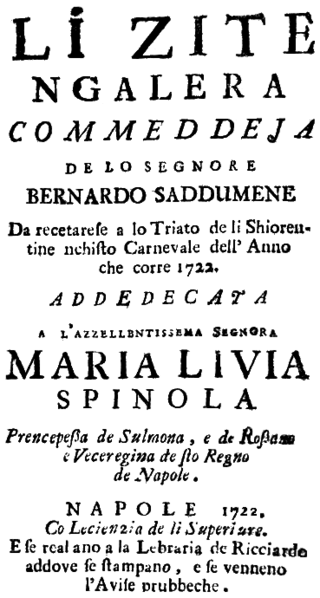
Li zite 'ngalera is a commedia per musica in three acts by the Italian composer Leonardo Vinci, first performed at the Teatro dei Fiorentini, Naples, on 3 January 1722. The libretto, by Bernardo Saddumene, is written in the Neapolitan language which characterizes it as commeddeja pe mmuseca.

The Teatro Santi Giovanni e Paolo was a theatre and opera house in Venice located on the Calle della Testa, and takes its name from the nearby Basilica of Santi Giovanni e Paolo, Venice. Built by the Grimani family in 1638, in its heyday it was considered the most beautiful and comfortable theatre in the city. The theatre played an important role in the development of opera and saw the premieres of several works by Francesco Cavalli, as well as Monteverdi's Il ritorno d'Ulisse in patria and L'incoronazione di Poppea.

Semiramide riconosciuta is an Italian opera with serious action, or dramma per musica, by Nicola Porpora, set to a libretto by Metastasio with some textual changes, possibly by Domenico Lalli. The opera was written for some of the finest contemporary singers, and includes a technically demanding series of da capo arias.

La villanella rapita is an opera giocosa in two acts by Francesco Bianchi with additional arias by Wolfgang Amadeus Mozart for its later performances in Vienna. The libretto was by Giovanni Bertati.
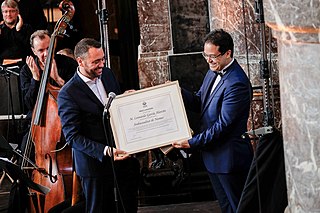
Leonardo García Alarcón is an Argentinian conductor specializing in baroque music.
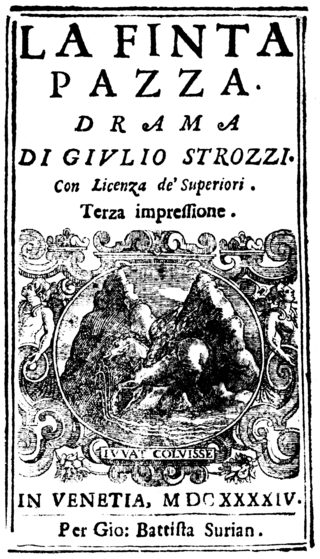
La finta pazza is an opera composed by Francesco Sacrati to a libretto by Giulio Strozzi. Its premiere in Venice during the Carnival season of 1641 inaugurated the Teatro Novissimo. It became one of the most popular operas of the seventeenth century.
Giovanni Filippo Apolloni was an Italian poet and librettist. Born in Arezzo, he has sometimes been referred to as "Giovanni Apollonio Apolloni", but the second given name is spurious. He served as the court poet to Ferdinand Charles, Archduke of Austria at Innsbruck form 1653 until 1659. On his return to Italy he entered the service of Cardinal Volumnio Bandinelli. After Bandinelli's death in 1667 Appolloni was in the service of the Chigi family in Rome and Siena for the rest of his life. He wrote the librettos for a number of operas, the most well-known of which were Antonio Cesti's L'Argia and La Dori, as well as several oratorios and the texts for cantatas by both Cesti and Alessandro Stradella.